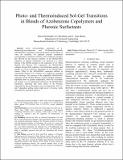Photo- and Thermoinduced Sol-Gel Transitions in Blends of Azobenzene Copolymers and Pluronic Surfactants
Author(s)
Deshmukh, Smeet; Bromberg, Lev; Hatton, T. Alan
DownloadMEBCS012.pdf (317.8Kb)
Metadata
Show full item recordAbstract
Novel self-assembling copolymers of 4-Methacryloyloxyazobenzene and NN-dimethylacrylamide (MOAB-DMA) exhibiting a pronounced photoviscosity effects in water are described. An optimum polymer architecture corresponding to maximum contents of the azobenzene moieties that allowed for the aqueous solubility of the MOAB-DMA copolymer at ambient temperature was observed at a molar fraction of the MOAB moieties in the copolymer of 0.2. When blended with Pluronic F127 copolymers, the MOAB-DMA solutions become both irradiation- and temperature-sensitive and capable of sol-gel transitions depending on the MOAB-DMA content. Effect of the MOAB-DMA copolymer addition to concentrated Pluronic F127 solutions was studied by controlled stress rheology. The presence of the amphiphilic MOAB-DMA copolymers in the micellar Pluronic solutions enabled irradiation-dependent shifts in gelation temperature, while the viscoelastic gel modulus was not significantly affected by the MOAB-DMA copolymers, indicating that cubic lattice of the Pluronic responsible for the gel formation was not compromised. The UV- and T-dependent gelling media might prove to become viable electrophoretic separation matrices.
Date issued
2006-01Series/Report no.
Molecular Engineering of Biological and Chemical Systems (MEBCS)
Keywords
Azobenzene, Pluronic F127, photoviscosity effect, N-dimethyl acrylamide